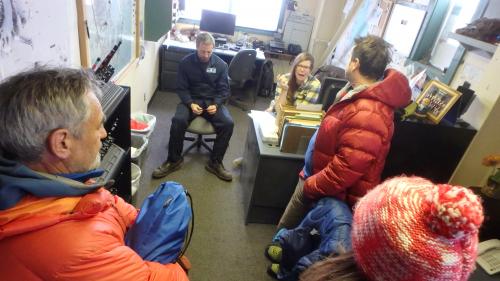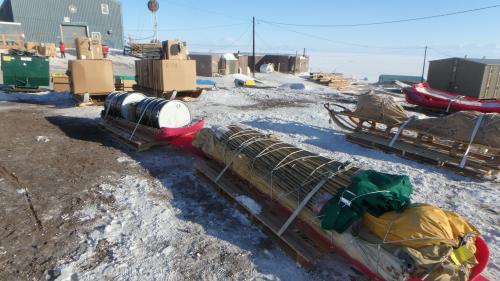It's getting to be that time – everything is falling into place. All the gear has officially arrived, the robots have checked out, the geophones (for seismic studies) are good to go, and the batteries for the GPS receivers are fully charged. Today was spent getting everything packed and the last of the meetings. The Shear Zone with its many crevasses is where we will be working throughout our field season out on the Ross Ice Shelf and the main overland route to the South Pole – the aptly name South Pole Overland Traverse – goes right through the area. The South Polar Overland Traverse (SPOT) crew is taking a large amount of our gear out with them when they head out to the Shear Zone to begin the yearly preparations of the route which involve the blasting and filling in of the crevasses that are in the area when they get too big.
We have enough gear that hauling it all ourselves would be prohibitive so the SPOT crews help out with their Caterpillar tractor trains to haul everything out there (along with their roughly 30,000 pounds of dynamite and det cord). We will be making the trip ourselves using 4 snowmobiles (pulling one sled with the survival bags on it) and 1 PistenBully (which will be hauling the robots and some personal gear) – a trip that will take us three hours via snowmobile and four hours on PistenBully.
Last of the Meetings
 Helo Ops briefing – making sure that everything is ready for the helicopter to come out once we are positioned. Pre-planning for the the very busy helicopters during season is extremely important.
Helo Ops briefing – making sure that everything is ready for the helicopter to come out once we are positioned. Pre-planning for the the very busy helicopters during season is extremely important.
As we near the day of departure for the field, the number of meetings decreases but two of the most important are left to the last: helicopter operations (HeloOps) and communications (comms). The helicopters here in McMurdo are in high demand during the season with all four of them being actively used and the seven pilots on continuous rotation. Scheduling those pilots and helicopters is a huge responsibility so we are sure to schedule our time with them. While in the field we will be having two visits from the larger helicopter to transport GPS equipment in and out in the shear zone where we cannot safely travel on foot or snowmobile. Without the helicopter the work that we need to do would be considerably more difficult.
 At MacOps – Communication with McMurdo is essential while we are in the field – whether that is via short-wave radio or sat phone.
At MacOps – Communication with McMurdo is essential while we are in the field – whether that is via short-wave radio or sat phone.
Even though we are out in the middle of nowhere, pretty much we can still get in touch with McMurdo (MacOps). We will be having VHF radio and satellite phone communication while in the field and Comms keeps track of us (as well as all parties out in the field) at all hours. Before we depart, we need to check out with MacOps (as the main communications center here at McMurdo is called) and we check in once we are done traveling and have made camp. In terms of daily routine at camp, we check in every day at 8:00am – if we are late checking in, things start to happen. After an hour, if MacOps has not heard from us the Emergency Operations Center (EOC) is activated and activity at McMurdo is shifted to focusing on where the missing team is. We also call in for our daily weather report if it's necessary to determine what activities we will be doing for the day.
As with everything here at McMurdo, safety is the primary concern and it's evident in the process and procedures that are in place to keep track of and prepare the various scientific teams that depart from here.
Food – Must. Have Food.
The food items that field teams can take is extensive here at McMurdo – everything from cooking supplies to spices to canned goods to chocolate bars to freeze-dried foods to steak and fish. My team put together a list of meals that we would be having on a rotational basis (so each Monday we would be having the same thing, and so on). From Mexican Night to Thai Night to steak and seafood, we will be eating very well which is good since the level of calories that we will be burning just to keep warm is considerable – add that onto actually doing physical exertion and the number of calories used explodes. Once the menu is selected it's sent over to the Berg Field Center where the helpful folks start pulling everything from the shelves and getting it staged. We then pack it all up and get it ready to go in smaller boxes which are then placed in the big boxes which are then placed on the sleds.
 The upper level of the Science Cargo building is dedicated to the food stores.
The upper level of the Science Cargo building is dedicated to the food stores.
 Thank God they had Chips Ahoy, peanut butter, Kraft Mac and Cheese, and chocolate – all is good with the world.
Thank God they had Chips Ahoy, peanut butter, Kraft Mac and Cheese, and chocolate – all is good with the world.
Pack It Up, Move It Out
 The sleds come in all styles from the big runners in the background, to the more traditional "sled dog" sleds, and the newer plastic sleds.
The sleds come in all styles from the big runners in the background, to the more traditional "sled dog" sleds, and the newer plastic sleds.
All the boxes than were packed with supplies earlier in the week, combined with the food boxes just packed, and now with all the other items from empty fuel drums, bamboo flags, ropes, jerry cans ... it all gets loaded onto the sleds and strapped down. Those sleds are then strapped down to pallets for transport from the staging area at the Berg Field Center to the waiting rubber mats in the currently ice covered harbor where the SPOT team is staging their equipment.


Comments